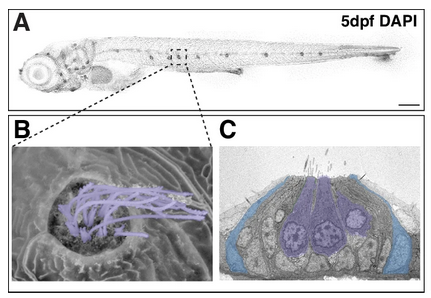HHF’s mission to fund hearing and balance research is only possible because of you.
The Hearing Restoration Project (HRP) is an international, collaborative research consortium focused on investigating inner ear hair cell regeneration using animal models to accelerate the timeline to a cure for hearing loss and tinnitus.
The Emerging Research Grants (ERG) program provides seed money to scientists researching underfunded areas of hearing and balance science, and for every dollar HHF invests, grantees receive on average $47 in major federal funding (2002–present).
Your generous support produced the following significant achievements this past year:
Ronna Hertzano, M.D., Ph.D., and Seth Ament, Ph.D., presented a cell census and atlas of cell types in the primary motor cortex of the mouse, marmoset, and human.
Bryan K. Ward, M.D., published a review of the history of surgery to treat Ménière’s disease, looking at how surgeons have been manipulating the membranous labyrinth to relieve episodes of vertigo while attempting to preserve hearing.
Using the chinchilla model, Vijaya Prakash Krishnan Muthaiah, Ph.D., found evidence of brain tissue damage from blast overpressure that results from mild traumatic brain injuries.
Anat V. Lubetzky, Ph.D., found that attentional resource-competition (the increased challenge to maintain position with a cognitive task) as well as a switch to a more automatic control of a stance took place simultaneously in her study examining how attention to a cognitive task affects balance.
Khaleel Razak, Ph.D., showed that older mice show difficulty with brain processing, whether or not they have significant hearing loss.
Ronna Hertzano, M.D., Ph.D., showed that data analysis of a large amount of information about individual cells, measuring them through multiple “omics” (such as genomics, transcriptomics, proteomics, epigenomics, and metabolomics), has advanced our understanding of biological sciences and medicine in an unprecedented way.
Research results by Hari Bharadwaj, Ph.D., suggested that neural processing of the temporal coherence of auditory stimuli is atypical in autism spectrum disorder, helping to explain why children with autism may experience auditory sensory overload.
Nirmal Kumar Srinivasan, Ph.D., found that difficulties in spatial and temporal processing co-occur in older individuals and individuals with reduced hearing acuity, helping to pinpoint how older adults can better hear speech in noise.
From his study involving a more diverse set of tinnitus sufferers in age and hearing ability than previous work on the question, Harrison Lin, M.D., concluded that for detecting tinnitus in humans, the clinical utility of conventional auditory brainstem response measurement is limited.
Research by Xiaodong Tan, Ph.D., is leading to a paradigm shift in cisplatin chemotherapy with the application of magnolia extract honokiol to reduce side effects including hearing loss. His ERG work formed the basis for his R01 project "Hearing Protection in Cisplatin Chemotherapy,” funded by the National Institutes of Health in February 2022.
Research by Snezana Levic, Ph.D., provided direct evidence that the functional expression of a specific ion channel (the SK current) may contribute to the patterning of spontaneous electrical activity in developing and regenerating chick tall hair cells.
Stefan Heller, Ph.D., showed that in the chick basilar papilla (equivalent to the mammalian cochlea) the expression of immune-related genes is tightly controlled and tied to a highly potent signaling pathway important for inflammation, cytokine storms, and fibrosis.
Hao Luo, M.D., Ph.D., provided proof of concept for measuring brain temporal responses to auditory nerve stimulation, which charts a path for future research to better understand the role of the neural activities involved in tinnitus.
As part of an international team that conducted a large meta-analysis of hearing genetics, Ronna Hertzano, M.D., Ph.D., uncovered 10 new gene variants linked to hearing loss.
Kenneth Vaden, Ph.D., examined neural mechanisms that may support speech understanding in noise and other difficult recognition tasks.
Auditory cortex research by Pierre Apostolides, Ph.D., may provide broadly generalizable insight into how the mammalian brain dynamically processes incoming sensory information.
Timothy Balmer, Ph.D., outlined lab protocols to better prepare balance organs for study in the mouse model, which are a challenge due to their location within the bony inner ear and their tiny size.
Building on her earlier research on hearing aid use and the brain, Samira Anderson, Au.D., Ph.D., found that the brain adjusts quickly to amplified sound but that its ability to fully interpret amplified signals in a meaningful way requires a longer period of time.
Matthew Masapollo, Ph.D., demonstrated a novel way to assess speech production using both electromagnetic articulography and electroglottography, useful for future cochlear implant investigations.







I had been a crewman on a destroyer and as I recall was never offered hearing protection during live firing. Naval guns are big and loud! After Covid I noticed difficulty understanding my patients, even with prescription hearing aids.